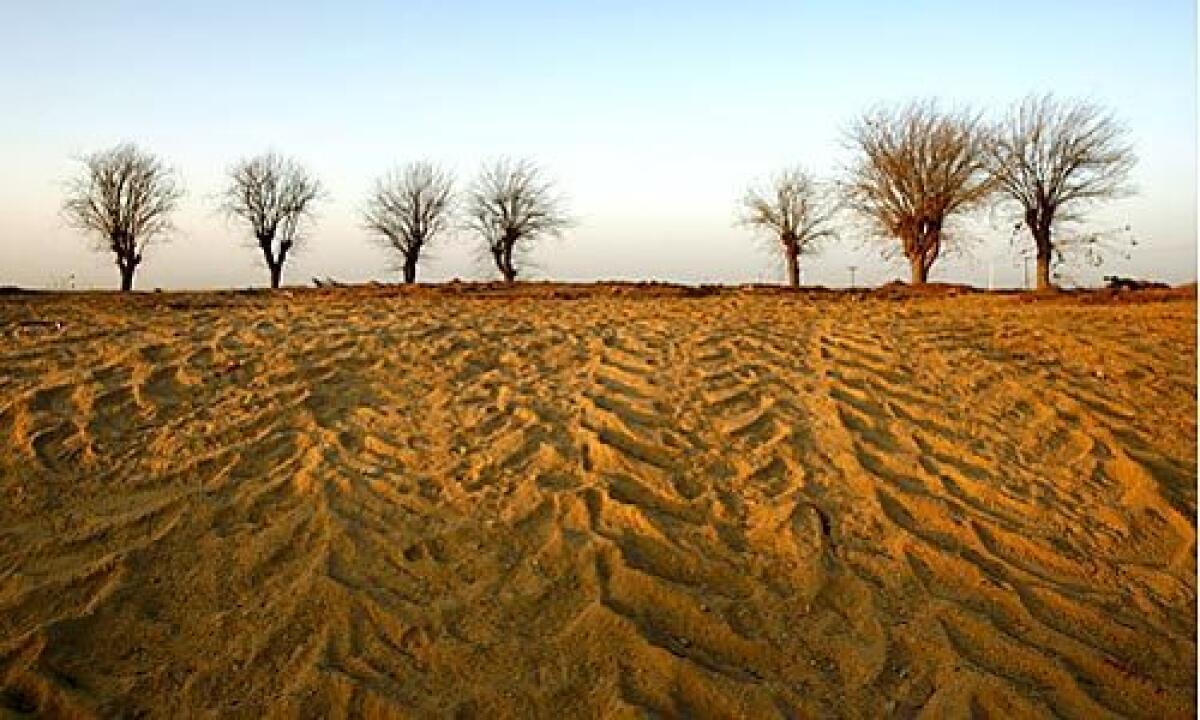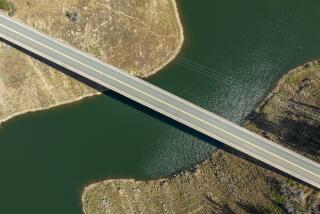Schwarzenegger proclaims that California is in a drought

- Share via
SACRAMENTO — Gov. Arnold Schwarzenegger proclaimed a statewide drought Wednesday, warning that California’s water supply is falling dangerously low because of below-average rainfall and court-ordered water restrictions aimed at protecting fish.
“We must recognize the severity of this crisis we face,” Schwarzenegger said at a Capitol news conference. He said this spring has been the driest on record in Northern California, which supplies most of the water to the state.
Along with the proclamation, the governor issued an executive order intended to speed transfers of water to areas experiencing the most severe shortages, help local water districts boost conservation efforts, identify risks to the state’s water supply and assist farmers.
The governor stopped short of declaring a water emergency. Administration officials say Wednesday’s move is a first step, putting Californians on notice that large-scale rationing could be coming if the situation does not improve. Some areas of the state are more vulnerable than others.
The governor said his proclamation adds urgency to a proposal he has been pushing for years to borrow $11.9 billion for new water projects such as reservoirs, river restoration and water-quality improvement. Schwarzenegger would like the Legislature to put such a plan on the November ballot, but lawmakers have balked amid opposition from environmentalists, who argue that new reservoirs threaten wildlife and fish habitats.
California has no official guidelines for what constitutes a statewide drought, and the governor’s proclamation this early in a dry spell is unusual. The state is in its second dry year.
When the last such proclamation was made, in 1991, former Gov. Pete Wilson waited until the fifth dry year. Only a month ago, the state’s meteorologist said California was not in a drought.
Administration officials say the governor is moving proactively because of unique circumstances that could cause the water situation to rapidly deteriorate. They point to a federal court order last summer aimed at protecting endangered smelt in the Sacramento-San Joaquin River Delta that has put a substantial share of the state’s water supply off-limits.
Additionally, state Department of Water Resources Director Lester Snow said odd weather patterns, perhaps related to global warming, are creating problems for the water supply.
The snowpack in the Sierra Nevada, which accounts for a large share of the state’s water supply, was at 97% of normal in March. By May it was down to 67% of normal. Warm weather throughout the spring caused the snow to melt quickly, Snow said, with much of the water evaporating instead of running downstream into reservoirs.
“The snowpack has been disappearing, and it has not manifest itself as runoff,” Snow said.
Most of the state’s residential customers are unlikely to face severe water rationing this year. But they are being asked to cut back their use. Major conservation campaigns have been underway in many parts of the state.
Water districts in several cities, including Long Beach and Oakland, are imposing restrictions on outdoor water use and are asking residential consumers to cut their overall use by 10% to 20%.
Washing cars and driveways is banned in some places, as is serving drinking water in restaurants unless the customer asks for it.
The Los Angeles Department of Water and Power on Wednesday voted to put such restrictions in place, subject to City Council approval. DWP officials said they expect to have up to 18 “drought busters” patrolling neighborhoods and ticketing offenders.
The Metropolitan Water District of Southern California, which serves 18 million people, will consider asking other member cities and counties to adopt such measures June 13. The proposed resolution would also encourage local governments to consider tiered rate structures that encourage conservation, mandatory installation of low-flow toilets when properties are resold, and rebates for consumers who install water-saving devices.
Timothy F. Brick, chairman of the district board, warned the state is “entering a new and worrisome water era.”
Farmers could be particularly hard hit. In the San Joaquin Valley, water shortages this year could force some to abandon tomato crops during the summer.
Schwarzenegger warns that conservation will help the state address such mounting water problems in the short term only.
“Our drought is an urgent reminder of the immediate need to upgrade California’s water infrastructure,” he said. “I hope the legislators get the point. . . . Let’s fix all of these things that need to be fixed rather than waiting and waiting and waiting.”
The governor noted that in 2006 the state had so much rain and snow that “raging storm water drained off into the ocean without us catching it” as large reservoirs released excess water. “Today, those same reservoirs are 40% below capacity. It is absolutely insane.”
Environmentalists on Wednesday said the governor’s call to bring his bond package before voters as soon as possible was misguided.
“I don’t think we are at this point where people are not going to have water if we don’t put his package on the November ballot,” said Jim Metropulos, a senior advocate with the Sierra Club.
The Sierra Club and other conservation groups said they would like to see a water bond package geared toward projects they view as more beneficial to the environment.
The Natural Resources Defense Council released a statement encouraging the governor to focus on his goal of reducing water usage in California cities by 20%. A bill the group sponsored that would set such a target for the state, AB 2175, recently passed the Assembly.
Times staff writers David Zahniser and Nancy Vogel contributed to this report.
More to Read
Sign up for Essential California
The most important California stories and recommendations in your inbox every morning.
You may occasionally receive promotional content from the Los Angeles Times.














